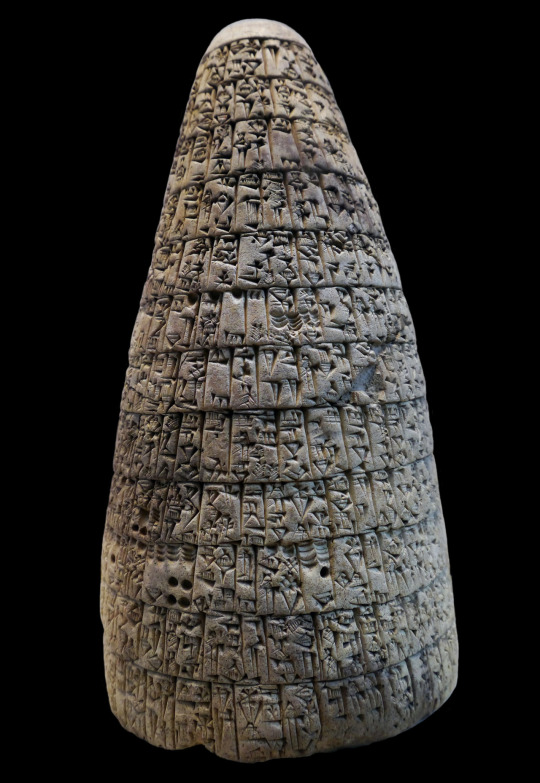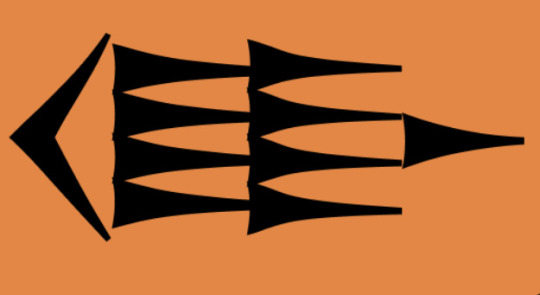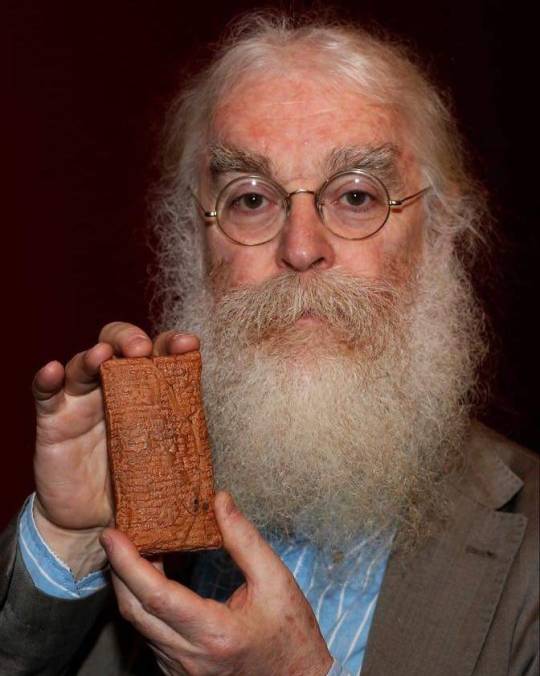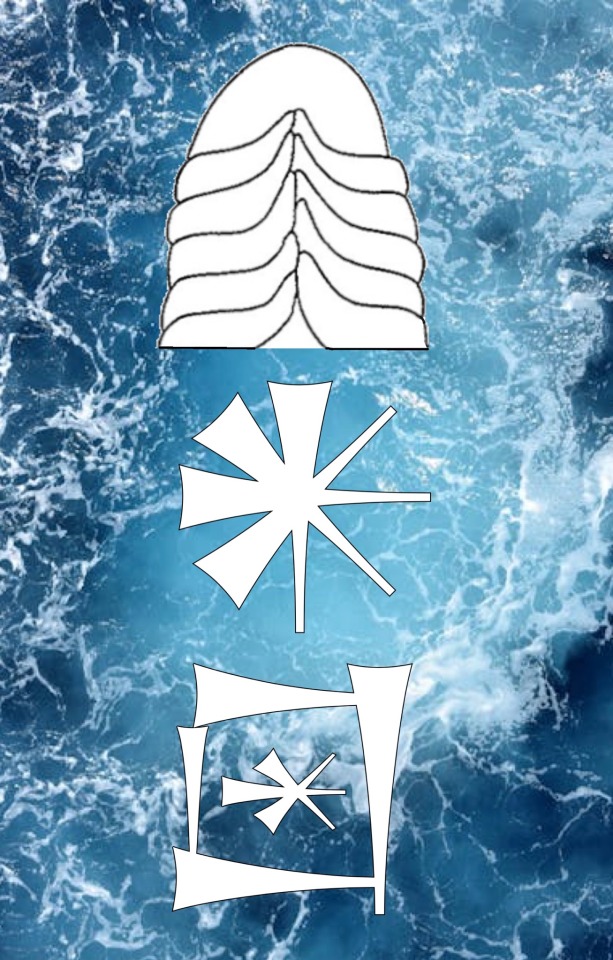#sumerian cuneiform
Text
The Early Dynastic Period of Mesopotamia is the modern-day archaeological term for the era in Mesopotamian history – 2900-2334 BCE – during which some of the most significant cultural advances were made including the rise of the cities, the development of writing, and the establishment of governments.
This era was preceded by the Uruk Period (4100-2900 BCE) when the first cities were established in the region of Sumer (southern Mesopotamia) and succeeded by the Akkadian Period (2334-2218 BCE) when Mesopotamia was conquered by Sargon of Akkad (r. 2334-2279 BCE) and ruled by him and his successors as the Akkadian Empire.
The term Early Dynastic Period was coined by Orientalist Henri Frankfort (l. 1897-1954 CE) to mirror the Early Dynastic Period in Egypt, a similar period of development. It should be noted, however, that the advances of Mesopotamia's Early Dynastic Period differed from Egypt's in significant ways, notably in that Mesopotamia – even under the rule of Sargon or later empires – was never the cohesive ethnic or political entity Egypt was and the kinds of cultural development cited for this era were not as uniform as they were in Egypt.
The city-states of Sumer were, for much of their history, each independently governed – not united under the reign of a single king as in the case of Egyptian government – and so a city like Uruk or Ur might have developed some important cultural advance which was not shared – at least not readily – with others.
The era is divided by archaeologists into three subperiods:
Dynastic I – 2900-2800 BCE
Dynastic II – 2800-2600 BCE
Dynastic III – 2600-2334 BCE
These are considered arbitrary divisions by some scholars and historians as there is no clear demarcation line separating one from the next. Even so, there is enough of a subtle difference that division is considered justified.
#studyblr#history#military history#archaeology#civilization#politics#sociology#invention#languages#writing#uruk period#early dynastic period (mesopotamia)#akkadian period#mesopotamia#sumer#akkadian empire#uruk#ur#iraq#kuwait#sargon of akkad#henri frankfort#sumerian language#cuneiform#sumerian cuneiform
1 note
·
View note
Text
Thus, Sumerian writing came to consist of a complex mixture of three types of signs: logograms, referring to a whole word or name; phonetic signs, used in effect for spelling syllables, letters, grammatical elements, or parts of words; and determinatives, which were not pronounced but were used to resolve ambiguities.

"Guns, Germs and Steel: A Short History of Everybody for the Last 13,000 Years" - Jared Diamond
#book quotes#guns germs and steel#jared diamond#nonfiction#language#writing#linguistics#sumerian cuneiform#babylonian cuneiform#sorry about the picture quality#it's just as shit in the book
0 notes
Text

414 notes
·
View notes
Text

Sumerian foundation figure, dating back to the Early Dynastic period around 2900–2350 BCE. The Pergamon Museum, Berlin, GERMANY.
Photo by Babylon Chronicle
275 notes
·
View notes
Text

brat sumer
#brat#brat summer#sumerian#sumer#ancient history#ancient languages#history#history memes#language#langblr#language blog#languageblr#language meme#language memes#cuneiform#charli xcx
60 notes
·
View notes
Photo

Cone of Urukagina, king of Lagash, circa 2350 BC,
Girsu, Mesopotamia,
Detailing his reforms againt abuse of "old days".
Height: 27 cm (10.6 in); diameter: 15 cm (5.9 in).
Collections of the Louvre (Department of Near Eastern Antiquities).
#art#design#sculpture#writing#words#king of lagash#girsu#mesopotamia#le louvre#cone#urukagina#styl#history#ideographic#cuneiform#sumerian
865 notes
·
View notes
Note
What does this actually mean?

Its a new tumblr badge
Hello! This is the sign 𒂂 dugud, which has several meanings including "weight, heavy, massive", "cloud" and "important, to be important". I assume it's being used in the latter meaning, designating the person as important here on tumblr dot com!
221 notes
·
View notes
Text


i need everyone to see this mesopotamian spell to get your baby to sleep from the library of Ashurbanipal ...people have always been the same, parent have always tried to find ways to get their children to sleep 🥹
#mesopotamia#history#cuneiform#babylon#photography#ancient#ancient history#sumerian#my post#british museum#writing#ancient writing#spells
38 notes
·
View notes
Text
"Blackbird" translated into the Akkadian (Ancient Babylonian) language (inspired by this lovely lute version)
Aškikītum ṣalmum tātallal- Blackbird, thou singest,
Kappīkī ḫepātim išî u ṣubbibī- Bear your broken wings and flutter,
Kala napištīkī- All your life,
Ūmum annûm tattaqî- You have waited for this day,
Šērtum ellētum qî- Wait for the holy morning.
Aškikītum ṣalmum tātallal- Blackbird, thou singest,
Atti uznīkī ṣalmūtim petî- Open your two black eyes,
Kala napištīkī - All your life,
Ūmum annûm tattaqî- You have waited for this day,
Anumma putaṭṭerī - Now be released.
Aškikītum- Bird,
Itaṣbibī- Fly
Aškikītum- Bird,
Itaṣbibī- Fly
Ina nannār burūmim- Into the light of the sky
Aškikītum- Bird,
Itaṣbibī- Fly
Aškikītum- Bird,
Itaṣbibī- Fly
Ina nannār ermiānim- Into the light of Anu’s canopy,
Aškikītum ṣalmum tātallal- Blackbird, thou singest,
Kappīkī ḫepātim išî u ṣubbibī- Bear your broken wings and flutter,
Kala napištīkī- All your life,
Ūmum annûm tattaqî- You have waited for this day,
Anumma putaṭṭerī - Now be released.
Ūmum annûm tattaqî- You have waited for this day,
Anumma putaṭṭerī - Now be released.
Ūmum annûm tattaqî- You have waited for this day,
Anumma putaṭṭerī - Now be released.
Ao3
14 notes
·
View notes
Text
How to Read Sumerian Cuneiform
Silim!
It is relatively difficult to translate between Sumerian and English in an exact, 1:1 way, so it requires a degree of creativity and contextual comprehension that AI and computer programmes have yet to achieve. I would like to demonstrate the process by which Sumerian can be translated into modern English in a way that still sounds coherent to a native English speaker.
I will use a line from one of my recent posts as an example. First, the cuneiform:
𒀉𒌫 𒈾𒉘𒉣𒈨𒋳𒍫𒉉𒉉 𒈾𒉘 𒊮𒋤𒀀𒁀 𒈾𒆪
This can be broken down into modern transliterated sign names
A2.UR2 NA.AG2.[NUN.ME.TAG].ZU5.[NE x A].[NE x A] NA.AG2 ŠA3.SUD.A.BA NA.KU
NA.AG2 is the emesal version of NAM (𒉆)
[NUN.ME.TAG] is how the word GAŠAM is written. Together, these signs form the word naŋgašam, which means “craftsmanship” (being the abstracted version of gašam, which means “expert, craftsman”)
ZU5.[NE x A].[NE x A] can be read as zu.ne.ne, which is the 2nd person plural possessive suffix. Altogether, this gives us naŋgašamzunene, which means “Your craftsmanship.”
NA.AG2, as with NAM, can also mean fate, destiny, determined order, will, testament, or in this case, concern.
ŠA3.SUD is how the word šagsug is spelt, which means “empty.”
A.BA is a locative addition that means “back” or “behind.”
A2.UR2…KU can be read a’ur dab, which means “to hide”
NA before 'dab' acts as a negator, making it “to not hide” or “not to hide,” or in this case as an imperative, “do not hide.” This gives us literally: “Your craftsmanship concern empty behind do not hide.”
We can rearrange this into English word order and get: “Do not hide your craftmanship behind empty concern.”
This is where the creativity and context come in. Craftsmanship can be interpreted as actions, deeds, or works. Empty concern can be understood as meaningless sentiment or a dishonest façade or performance.
This would make it: “Do not hide your actions behind meaningless sentiment.”
Or: “Do not hide your deeds behind a dishonest façade.”
All of this can be more easily communicated in English by simply saying “Practice what you preach.”
If you would like to dive in to this more, here are some links to some very good resources I’ve found online that try to reconstruct Sumerian:
Pennsylvania Sumerian Dictionary:
http://oracc.iaas.upenn.edu/epsd2/index.html
Šašková Cuneiform Sign List:
Sumerian Grammar
I am also working on compiling all of this information into a more approachable format with the hope of laying the foundation for resurrecting the Sumerian language in the 21st Century.
I will also be posting an English translation of my earlier post eventually, but I want to see if anyone takes a stab at translating it on their own first. If you think you've got it, feel free to message me your translation!
©️𒀭𒀹𒁯 2024
#ishtar#sumer#language#linguistics#sumerian#Sumerian language#ancient sumer#pagansim#ancient cultures#ancient history#cuneiform
16 notes
·
View notes
Photo

Stone tablet with proto-cuneiform inscription
Mesopotamia (Iraq), probably Girsu (modern Tello)
Early Dynastic period, ca. 2750-2500 BCE
The text records allocations of land to various individuals, and it mentions the name of a certain Enhegal, who seems to bear the title “king (lugal) of Lagash,” but who is otherwise not attested in historical sources.
Penn Museum, Philadelphia, PA, CBS 10000
https://www.penn.museum/collections/object/347463
207 notes
·
View notes
Text
The Sumerians were the people of southern Mesopotamia whose civilization flourished between c. 4100-1750 BCE. Their name comes from the region which is frequently – and incorrectly – referred to as a “country”. Sumer was never a cohesive political entity, however, but a region of city-states each with its own king.
Sumer was the southern counterpart to the northern region of Akkad whose people gave Sumer its name, meaning “land of the civilized kings”. The Sumerians themselves referred to their region simply as “the land” or “the land of the black-headed people”.
The Sumerians were responsible for many of the most important innovations, inventions, and concepts taken for granted in the present day. They essentially “invented” time by dividing day and night into 12-hour periods, hours into 60 minutes, and minutes into 60 seconds. Their other innovations and inventions include the first schools, the earliest version of the tale of the Great Flood and other biblical narratives, the oldest heroic epic, governmental bureaucracy, monumental architecture, and irrigation techniques.
After the rise of the Amorites in Mesopotamia, and the invasion of the Elamites, Sumer ceased to exist and was only known through references in the works of ancient writers, including the scribes who wrote the biblical Book of Genesis. Sumer remained unknown until the mid-19th century CE when excavations in Mesopotamia unearthed their civilization and brought their many contributions to light.
#studyblr#history#prehistory#archaeology#civilization#politics#sociology#technology#invention#horology#languages#writing#sumerian religion#judaism#christianity#fertile crescent#mesopotamia#sumer#amorites#elam#iraq#kuwait#sumerian language#akkadian language#cuneiform#sumerian cuneiform
1 note
·
View note
Text
The two undisputably independent inventions of writing were achieved by the Sumerians of Mesopotamia somewhat before 3000 B.C. and by Mexican Indians before 600 B.C. (Figure 12.1); Egyptian writing of 3000 B.C. and Chinese writing (by 1300 B.C.) may also have arisen independently. (...) The independent invention that we can trace in greatest detail is history's oldest writing system, Sumerian cuneiform (Figure 12.1).

"Guns, Germs and Steel: A Short History of Everybody for the Last 13,000 Years" - Jared Diamond
#book quotes#guns germs and steel#jared diamond#nonfiction#writing#language#linguistics#sumerian cuneiform#mesopotamia#mesoamerica#Egypt#china#writing systems
0 notes
Text

Dr Irving Finkel holding a 3770-year-old tablet, that tells the story of the god Enki speaking to the Sumerian king Atram-Hasis (the Noah figure in earlier versions of the flood story) and giving him instructions on how to build an ark which is described as a round 220 ft diameter coracle
More: https://bio.link/museumofartifacts
154 notes
·
View notes
Photo

Sumerian Cuneiform tablet from the ancient city of Ur, dating back to 2100-2000 BCE. Museum of the Bible, Washington, DC.
Photo by Babylon Chronicle
149 notes
·
View notes
Text
Namma/Nammu
𒀭𒇉
Sumerian Goddess, primarily from the city of Eridu
Mother of the Gods. Creator of Mankind, specifically in Eridu, elsewhere this role went to Nintur or Ninmah
—How to use internet archive link
🔵 Information
From Gods Demons & Symbols by Black [Internet Archive Link]
"Nammu was a goddess who was considered, in some traditions, to have given birth to An (heaven) and Ki (earth) and to many more of the more ancient gods. Especially she was regarded as the mother of Enki. She came to be thought of as one of the mother goddesses. Her name is written with the same sign as engur, a synonym of abzu, and it is probable that she was originally a personification of the subterranean ocean." [p134]
Dictionary of Ancient Near Eastern Mythology by Leick [Internet Archive Link]
Her name is usually written with the sign engur which was also used to write Apsu. In ancient times she personified the Apsu as the source of water and hence fertility in lower Mesopotamia. She may well have been worshipped in Eridu before Enki, who took over most of her prerogatives and functions. Significantly he was called the son of Nammu. In spite of her decline following the superiority of Enki, during the Neo-Sumerian period, at least at Ur, she was still considered important enough to have statues commissioned in her honour and she also features in the name of the famous king Ur-nammu. In mythology, Nammu appears as the primeval Mother-goddess in Enki and Ninmah who 'has given birth to the great gods'. She has the idea of creating mankind as a help for the gods and it is she who goes to wake her son Enki, asleep in the Apsu, that he may set the process going. [p 124]
Handbook of Gods & Goddess of the Ancient Near East [Google Books Link]:
"Namma: Sumerian goddess of the primeval, subterranean ocean. In the lexical series Diri the name has a syllabic rendering na-am-ma. In some traditions she was the mother of the sky god An, the earth goddess Ki, and a number of other deities. Enki/ Ea, the god of freshwater and wisdom, was considered her son. In the myth of "Enki and Nin-mah," when the other deities began complaining about how hard they had to work, it was Namma who awakened Enki from his sleep to urge him to create more creatures to take on the work of the gods. However, he delegated the task to Namma, who then received the credit for creating human beings. There was a shrine to the goddess in Marduk's great temple at Babylon, and at least one other of her sanctuaries is known"[p222]
Excerpt from Oracc [Link]:
"Very little is known about Namma, who belongs to the oldest generation of Mesopotamian deities and is associated with the pantheon of Eridu. She is mainly known for her role in the cosmogony of early Mesopotamia and her importance in magic, which is restricted to texts written in Sumerian [...]. According to the god list An-Anum, tablet I line 28 [...], Namma bears the title "mother who gave birth to the heavens and the earth. Because this goddess's name is written with sign for "(cosmic) subterranean waters" (Sumerian: engur) Wiggermann [..] has called her the "Cosmic Ocean. [...] In the Sumerian poem of Enki and Ninmah (ETCSL 1.1.2, line 17 link) Namma is called the "original mother who gave birth to the gods of the universe", again according her primary status among all the gods and describing her role in Mesopotamian cosmogony"
Section from Enki & Ninmah (ETCSL 1.1.2) [Link]
*Bolded part that explains her mother of Gods role, and also her creating man (different deities depending on myth)
*How deity, people, and place names are spelled is wildly inaccurate in the ETCSL, they don't even follow their own rules. But I still did not change the quote
"The gods said, weeping: "He is the cause of the lamenting!" Namma, the primeval mother who gave birth to the senior gods, took the tears of the gods to the one who lay sleeping, to the one who did not wake up from his bed, to her son: "Are you really lying there asleep, and ...... not awake? The gods, your creatures, are smashing their ....... My son, wake up from your bed! Please apply the skill deriving from your wisdom and create a substitute for the gods so that they can be freed from their toil!" At the word of his mother Namma, Enki rose up from his bed. In Hal-an-kug, his room for pondering, he slapped his thigh in annoyance. The wise and intelligent one, the prudent, ...... of skills, the fashioner of the design of everything brought to life birth-goddesses. Enki reached out his arm over them and turned his attention to them. And after Enki, the fashioner of designs by himself, had pondered the matter, he said to his mother Namma: "My mother, the creature you planned will really come into existence. Impose on him the work of carrying baskets. You should knead clay from the top of the abzu; the birth-goddesses will nip off the clay and you shall bring the form into existence. Let Ninmah act as your assistant; and let Ninimma, Cu-zi-ana, Ninmada, Ninbarag, Ninmug, ...... and Ninguna stand by as you give birth. My mother, after you have decreed his fate, let Ninmah impose on him the work of carrying baskets."
The Harps That Once by Jacobsen [Google Books Link]
"Namma, Enki's mother, was probably seen as the power in the riverbed which, empty or nearly empty in summer, gives birth to the fresh waters, to Enki, in the spring flood. This interpretation gains a measure of support from the fact that the cuneiform sign with which her name was written served also, if supplemented with the sign for "water," to write the word for "river." Etymologically the name Namma goes back to Nin-imma (nin-immaran-amma nama›namma) "lady female genitals," a personification of the numinous power to shape, mature, and give birth to the child, and it is as birth goddess generally, rather than as goddess of the riverbed, that the text here characterizes her. That latter aspect she may conceivably have acquired because the mythopoeic imagination conceived of the great gash in the earth which the dry riverbed presents as the genitals of Mother Earth herself, and the prototype of all female parts everywhere. Namma's role as birth goddess generally and as the one who gave birth to man probably represents a local tradition, perhaps at home in Eridu. Elsewhere it is the goddess Nintur, or Ninmah as she is called in this composition," [p 158]
From Wiggermann "Nammu" [PDF Link]
*He disagrees with Jacobsen on Nin-imma, but Wiggmann addresses many other authors both agreeing and disagreeing but its too densely written for me to even remotely understand the back & forth between the Assyriologists.
"Nammu is an ancient goddess of Eridu, who plays a part in the local (and early national) mythology as creatrix/mother goddess and as supporter of Enki in Magic. Most references relate to either of these two roles [...] Only her epithet "(^munus)agrig-zi-é-kur-(ra-)ke", "true housekeeper of Ekur" points outside Eridu to the pantheon of Nippur, but it may be due to a confusion with Nin-imma, Enlil's scholar and scribe." [p 137 Column 2]
🔵 Titles / Epithets
*I did not use š, ḫ, or ĝ when typing these for ease of reading. See Sisterofiris' posts on transliterations [link] & normalizations [link]. Page numbers correspond to Wiggermann's Nammu PDF, linked above.
🔹Amaùtuanki — "Mother who gave birth to Heaven and Earth" (p137 column 2)
🔹Ama-palil-ù-tu-dingir-shár-shárra-ke-ne — "Mother, who gave birth to all the gods" [I kept dashes so it can be read] (p138 column 1)
🔹Amarhusheke — "Compassionate Mother" (p138 column 2)
🔹Amagal — "Great Mother" (p138 column 2)
🔹Agrigziékurrake — "True housekeeper of Ekur" (p137 column 2)
🔹Amadingirdingira | Modern— [Link]
"Mother of (the) Gods" in Sumerian
𒂼 — Mother, ama [Link]
𒀭𒀭— Many Gods, dingirdingir [Link]
𒀝 - "of" genetive case suffix, .a(k) [Link]
🔵 Iconography
She has no known iconography that has been found yet according to Oracc.
I made these tonight on my phone. Left has an ocean as its background to represent the "Cosmic Sea" aspect.
Its the Mesopotamian horned cap/crown of divinity then her name 𒀭 (diĝir) and 𒇉 (engur)


(click on right its not cut off as mobile shows)
#polytheism#paganism#nammu#namma#annunaki#sumerian#sumer#mesopotamia#mesopotamian#eridu#deity#deities#god#goddess#divine#mother goddess#primordial sea#levpag#cuneiform#cuneiform journey#deity resource#landof2rivers
16 notes
·
View notes